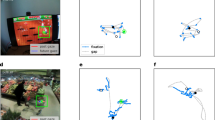Abstract
Binocular information has been shown to be important for the programming and control of reaching and grasping. But even without binocular vision, people are still able to reach out and pick up objects accurately – albeit less efficiently. As part of a continuing investigation into the role that monocular cues play in visuomotor control, we examined whether or not subjects could use retinal motion information, derived from movements of the head, to help program and control reaching and grasping movements when binocular vision is denied. Subjects reached out in the dark to an illuminated sphere presented at eye-level, under both monocular and binocular viewing conditions with their head either free to move or restrained. When subjects viewed the display monocularly, they showed fewer on-line corrections when they were allowed to move their head. No such difference in performance was seen when subjects were allowed a full binocular view. This study, combined with previous work with neurological patients, confirms that the visuomotor system “prefers” to use binocular vision but, when this information is not available, can fall back on other monocular depth cues, such as information produced by motion of the object (and the scene) on the retina, to help program and control manual prehension.
Similar content being viewed by others
Author information
Authors and Affiliations
Additional information
Received: 22 December 1997 / Accepted: 4 February 1998
Rights and permissions
About this article
Cite this article
Marotta, J., Kruyer, A. & Goodale, M. The role of head movements in the control of manual prehension. Exp Brain Res 120, 134–138 (1998). https://doi.org/10.1007/s002210050386
Issue Date:
DOI: https://doi.org/10.1007/s002210050386




